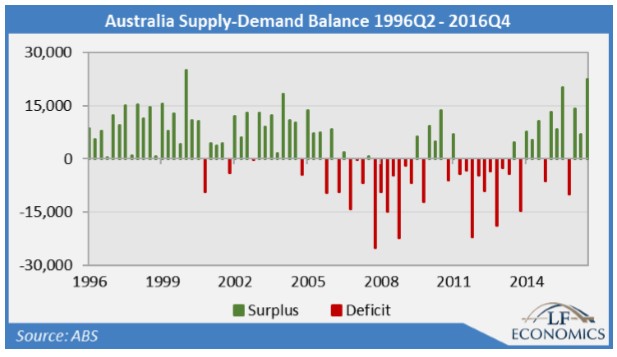Below are some key extracts:
Australia has experienced a nationwide boom in real and quality-adjusted housing prices. It began in 1996 and has risen continuously to the present day. This is the longest continuous trend of rising prices since records began in 1880. Government, industry and academia have attributed the price boom to many fundamental factors, with a dire shortage of dwellings often cited as a major cause.
These parties argue Australia’s capital cities suffer from a constant deficit of dwelling construction…
LF Economics has analysed the data to show the shortage is a myth, and a considerable surplus has emerged over the course of the housing price boom…
The best and most commonly used method to determine the supply-demand balance in a time period (usually denoted in quarters or years) is to compare the flow of new net dwellings to new net households, once appropriate adjustments are made for replacement or demolished dwellings and those considered secondary (i.e. holiday homes). Not only can the balance be accurately calculated for each time period, the cumulative net balance across the time series can be calculated by added together all the surpluses and deficits…
The supply-demand balance ratio is interpreted as follows: a value of 0 demonstrates a balanced market, a value less than 0 indicates a deficit, while a value greater than 0 indicates a surplus…
The ratio indicates the nationwide housing market was in surplus for the majority of the time between the baseline of 1996Q2 and the current quarter…
A contradiction lies at the heart of commentary on supply: while economists generally accept that rising housing prices provides incentive for developers and builders to supply increasing numbers of dwellings, historically high and rising prices are often blamed, in part, on a dwelling shortage. It is difficult for both conditions to hold true. In this instance, it is the former, not the latter, as revealed by the dwelling supplydemand balance and cumulative running total.
The report, which contains 15 graphics as well as analysis at the state and territory level, is available here.


